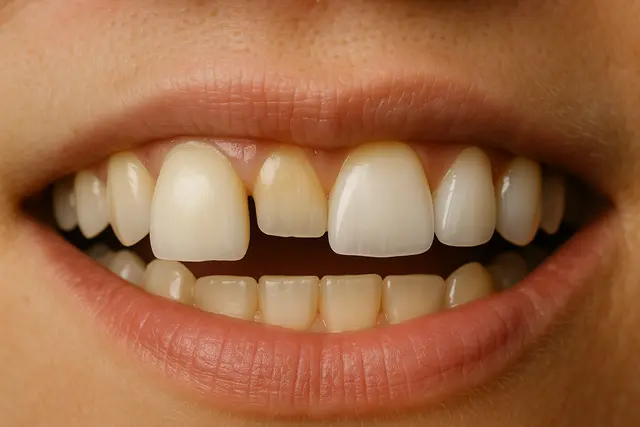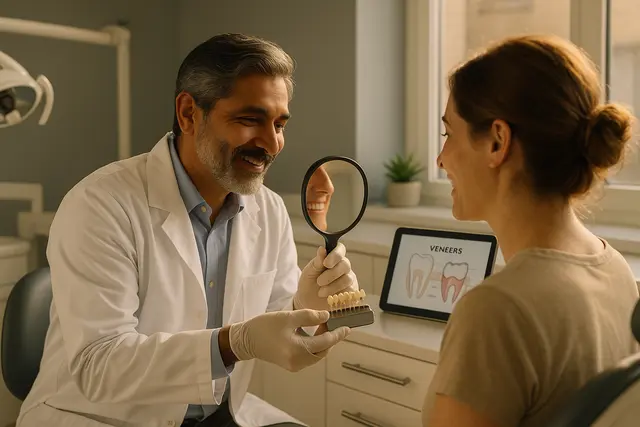Cosmetic Dentistry
6 min read
May 13, 2025
Crown Prep vs Veneer Prep: Which One Does Your Smile Need?
Thinking about upgrading your smile but stuck between a crown and a veneer? You’re not alone. Both options can transform your teeth, but they serve different purposes.

Let’s say you’re standing in front of the mirror, giving your teeth the side-eye. Maybe there’s a chipped edge, a discolored tooth that no amount of whitening strips can fix, or maybe your dentist just threw out a word that made your eyebrows hit your hairline: crown. Or was it veneer? Suddenly, you’re Googling things like “veneers vs crowns” or “what’s the difference between a veneer and a crown prep?”
We get it, nobody wants to make the wrong choice when it comes to their smile. So let’s walk through the differences between the two, what each prep involves, and how to decide which one your tooth (and wallet) really needs.
Understanding the Basics: Crown Prep and Veneer Prep
Crown prep is like full-body armor for a tooth. When a crown is needed, your dentist removes a substantial amount of the natural tooth, on all sides and top, so the new dental crown can fit snugly over it. This is usually done when a tooth is badly damaged, decayed, or weakened after a root canal.
Veneer prep, on the other hand, is more like tailoring a custom shirt that just covers the front surface of your tooth. For a veneer, your dentist removes a much thinner layer, usually just from the front of the tooth, so the new layer can be bonded. Porcelain veneers and composite veneers are the two common types, and they’re more about enhancing looks than restoring major damage.
In short? A crown covers the entire tooth and crowns are used when strength and protection are needed. A veneer is in place for cosmetic upgrades and minor issues.
The Veneer Prep Experience
If you're thinking of cosmetic veneers, veneer prep is generally less invasive. Your dentist will shave off about half a millimeter from the surface of your teeth, just enough to bond the thin layer of porcelain or composite. It’s not a full day at the spa, but it’s also not as intense as a crown prep.
This prep keeps most of your natural teeth intact, which many patients love. Veneers don’t usually require much recovery time, and you’ll probably walk out with a temporary veneer while your final one is being made.
That said, veneers require solid foundations. If your tooth is too cracked, has had a root canal, or just doesn’t have enough structure left, a veneer may not be enough support.
What to Expect with Crown Prep
Now, crown prep is a bigger deal. Your dentist will remove enough tooth structure so the crown fits over it like a cap. This process often takes two appointments. During the first visit, they’ll place a temporary crown to protect your tooth while the permanent crown is ready from the lab.
Crowns provide more than just aesthetics, they restore function. They help you chew without worry, especially if your tooth is cracked, broken, or has a huge filling. Crowns can help even out bite pressure, and in some cases, your dentist may use a porcelain fused to a metal version for added durability.
One small downside? Sometimes a crown shows a thin dark line at the gum over time, especially if porcelain fused crowns are used. If that bugs you, you might want to explore all-porcelain crowns or zirconia instead.
Veneer vs Crown: The Aesthetic Question
Still stuck on veneer vs crown? Here’s where it gets tricky: they both make your teeth look great. Veneers offer a super natural look, often used on front teeth to fix discoloration, small gaps, or chipped teeth. The result is a stunning smile makeover with minimal invasiveness.
Crowns, while not exclusively cosmetic, can still be made to look natural and beautiful, especially porcelain crowns. They’re often used when the function of your teeth is just as important as the look.
But remember: veneers and crowns are similar only on the surface. When you’re deciding between crowns and veneers, it really comes down to how much tooth structure is left and what your dental goals are, appearance, strength, or both.
Pros and Cons of Veneers and Crowns
Let’s break it down like a real-life pros and cons list (because let’s face it, that’s how most of us decide anything).
Pros of Veneers:
Less invasive than crowns
Great for improving shape, color, and alignment
Preserve more of your natural teeth
Cons of Veneers:
Veneers don’t work well on damaged teeth
Can chip or fall off if you grind or clench your teeth
Not always covered by dental insurance
Not suitable for back teeth that need strength
Pros of Crowns:
Crowns provide full coverage for weak or broken teeth
Restore function for chewing
Can last 10–15 years or more with good dental hygiene)
Often necessary after root canal treatment
Cons of Veneers and Crowns:
Both require altering your tooth structure
Crowns vs veneers: crowns are more invasive
You’ll likely need replacements eventually
Crown requires more prep time and can feel more dramatic
Good Candidate for Veneers?
You might be a good candidate for veneers if your teeth are generally healthy, but you want to tweak things cosmetically, like closing small gaps, masking stains, or reshaping front teeth.
Composite veneers cost less upfront, but they’re also less durable than porcelain. So weigh your options and understand the potential sensitivity or discomfort some people report.
If you clench your teeth at night or have heavy wear, though, a veneer or crown discussion is a must. Because veneers are thin, too much pressure can crack them. And yes, you can get cavities under veneers.
When to Choose a Crown Instead
You’ll probably need a dental crown if your tooth has a massive cavity, crack, or after dental procedures like a root canal. A crown may also be the go-to if you’re missing a tooth and getting dental implants, since the crown fits over the implant base.
If your dentist suggests a temporary crown, don’t panic, it’s a placeholder, like a fitting jacket before the final tailoring. Once the permanent crown is ready, they’ll secure it and make any final tweaks to make sure the bite’s just right.
Let’s Talk Materials
Both veneers and crowns can help with appearance, but materials make a difference in how long they last and how natural they look.
Porcelain or other materials like zirconia are common for both. Porcelain dental options look great, but for durability, especially for molars, a crown material like metal-fused porcelain may work better. Veneers are used primarily for beauty, while crowns are often chosen for strength and long-term wear.
Choosing Between Crowns and Veneers: Ask These Questions
Before you decide between veneers vs crowns, ask yourself (or your dentist):
Is my tooth structure strong enough to support a veneer?
Do I grind or clench at night?
Is this more about appearance or function?
Will dental insurance cover either one?
Am I fixing front teeth or back teeth?
If you’re trying to decide between crowns or veneers, think long-term. A smile that looks amazing but can’t bite into an apple isn’t doing its job. Likewise, a bulletproof crown that’s off-color might not feel like a win either.
Smile Smart, Not Just Pretty
We get it, it’s your smile. It’s the first thing people see, and you want to get it right. The good news is, both options, veneers and crowns, can transform how you look and feel. But knowing the difference between veneers, how crowns can help, and which dental restoration matches your needs is key.
Your dental office or dental clinic isn’t just there to patch things up. They’re your partner in getting a smile that works and wows. So bring your questions, talk materials, compare procedures, and make the call that makes sense for you.
What Is the Main Difference Between a Veneer and a Crown?
A veneer covers only the front surface of a tooth and is mainly used for cosmetic enhancements like discoloration, chips, or gaps. A crown, however, covers the entire tooth and is typically used when a tooth is damaged, decayed, or weakened. Crowns offer full protection, while veneers are ideal for improving appearance with minimal tooth reduction.
When Should I Choose a Crown Instead of a Veneer?
A crown is the better choice when a tooth is structurally compromised, such as after a root canal, a large filling, or a crack. It restores function and durability. If your tooth has enough healthy structure left and you're mainly concerned about looks, a veneer may be more appropriate.
Are Veneers Less Invasive Than Crowns?
Yes. Veneers require only minimal enamel removal, typically from the front of the tooth, while crowns involve reshaping the entire tooth. This makes veneers less invasive and better at preserving your natural tooth, but they’re not suitable for teeth that need full restoration or extra strength.
How Do I Decide Between Veneers and Crowns for My Smile?
It depends on your dental needs. If you want a cosmetic boost and have healthy teeth, veneers are a great choice. If you're dealing with decay, fractures, or prior dental work, crowns offer the protection your tooth needs. Your dentist will evaluate tooth condition, function, and aesthetic goals to guide the best option.Ask ChatGPT
Read Next
Related Posts

Cosmetic Dentistry
Looking for a Dentist Who Whitens Teeth? Here’s What to Know First
A brighter smile can do wonders for your confidence, but finding the right dentist who whitens teeth takes more than just a quick Google search. From treatment options to experience and safety measures, there are a few key things you should know before booking that whitening appointment.
3 min read
Sep 10, 2025

Cosmetic Dentistry
What Type of Dentist Does Veneers? Here’s Who to Trust With Your Teeth
Dreaming of a flawless, photo-ready smile? Veneers can be a game-changer, but only if you choose the right expert to apply them. Understanding who’s qualified to handle this cosmetic procedure is key to getting results that look natural and last for years.
5 min read
Sep 08, 2025

Cosmetic Dentistry
Cosmetic Dentistry and Implants: How They Work Together
A confident smile can do wonders for your self-esteem, and modern dentistry offers more ways than ever to achieve it. Whether you're dealing with missing teeth or simply want a brighter, more balanced look, cosmetic dentistry and dental implants provide powerful solutions that work hand-in-hand to restore both function and aesthetics.
5 min read
Sep 05, 2025
Don’t have time to research every dentist around you?
See why 30k+ patients trusted us